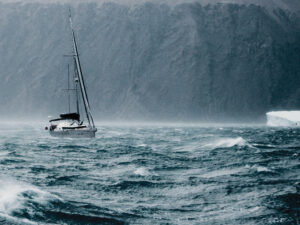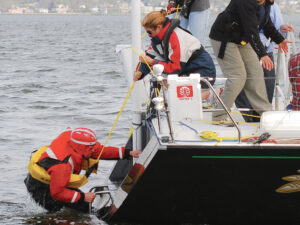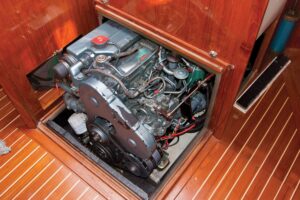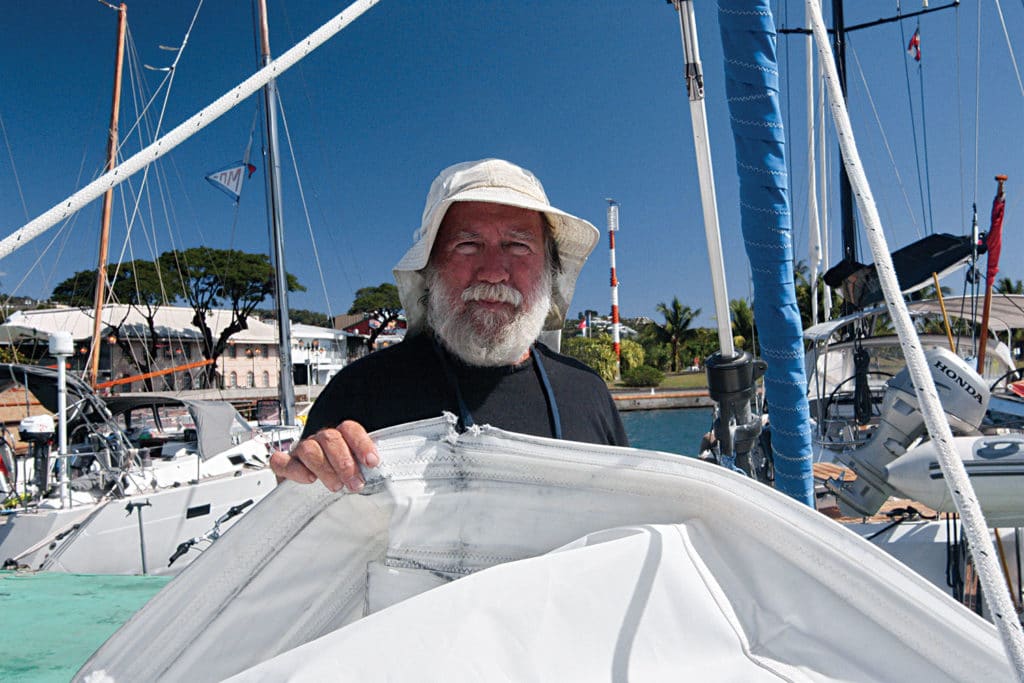
The list of things to do before we could set off across the Pacific aboard our “new” 30-plus-year-old vessel was extensive and included installing a new, bigger engine, which required getting thousands of tiny technical details exactly right.
So at first, I really wasn’t thinking about our rig as my wife, Carolyn, and I strolled by L. Richardson’s rigging shop on the Tortola waterfront in the British Virgin Islands.
But then an alarm went off in the back of my head. “Ah!” I said to Carolyn, as I turned back toward Richardson’s, “the roller-furler screws!”
L. is “an island mon, me son,” and throws nothing away. Thus, while all the outlets in America no longer stocked the two tiny screws I needed to fix the connecting plate between two sections of the furler’s foil, L. had a handful of them in a rusty coffee can. I asked for two; he gave me four. “No charge,” he said with a wide, toothy grin. “And how’s the new boat coming along?”
“Tanks, mon.” I smiled back at L. “Dat’s a sweet price!”
“I doan want to hear another yachtie crying ’bout de high cost of cruising, Fatty!”
I have a special future-projects drawer aboard Ganesh, our Wauquiez 43 ketch. But these screws were tiny. So I put them in a small zip-lock bag with a note and carefully tucked them in a safe place. Or, to put it another way, I lost them in the endless nooks and crannies of our 30,000-pound vessel, perhaps forever.
Before we left the Virgins, I searched Ganesh from stem to stern twice for the screws. But they gradually slid from my consciousness, as the joining piece between the foils still had two of its original four fasteners, and they appeared to be corroded in place regardless.
Once through the Panama Canal, Carolyn suggested, “Let’s try for the Gambiers one more time.” These are a tiny group of seldom-visited French islands at 23 degrees south, which we’d tried to reach on our last lap of the planet, but were beaten away by adverse weather.
“Gambiers it is,” I sang out, “but you’d best pray for the easterly trades, or we won’t be able to enter again!”
One day while on our way, as I attended to our ship’s business, I noticed that our new storm staysail had suddenly developed an oil spot on it. I’d lubricated both my furling headsail units just before leaving Panama, and concluded that I must have used a tad too much oil on the aft one and it had bled onto the Dacron.
“No big thing,” I thought to myself at the time.
Out cruising, we have to be flexible and plans can change, but that doesn’t lessen the hand we were dealt when, after 37 days at sea aimed at the Gambiers, I was forced to ease sheets and fall off for Tahiti, 900 miles away. We made this safety-first call for two reasons: We were hard on the wind and being severely pounded by a deepening southerly gale, and the oil stain on the staysail wasn’t merely an oil stain. No, the inner connecting link between the foils had jiggled loose those aforementioned two remaining screws and had fallen downward, which caused the sail to tear, not stain.
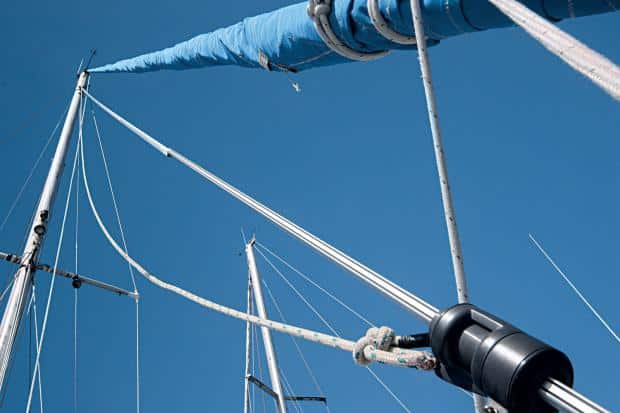
The result was that my storm staysail was fully deployed, and with the aluminum foil now in two separately flapping pieces, I didn’t think I could reef the sail without the furler jamming, nor could we take down the sail without it binding in the track. This as a gale was approaching.
I had to run off, at least until the storm, forecast to dissipate soon, subsided. When things calmed down, I could go aloft to take down the staysail without damaging it. This was a good plan and a logical plan — that didn’t work at all. The wind gods, alas, hadn’t received the same weather report. Already, the seas were impressive and the wind just built and built until it was a steady 42 knots and gusting into the 50s.
In order not to broach, I began towing things: one fender, two fenders, anchors, then spare rodes and another seven fenders, and finally old tarps and rotten sails.
Meanwhile, the weather kept deteriorating.
The digital barometer was shouting storm warnings and delivering rapid change alerts. Our windvane was struggling, steering for a few minutes, but then letting Ganesh round up. And so I had no choice but to sit stoically in the howling cockpit, to quickly twist Ganesh back on course as needed.
By the evening of the second day, for only the fourth time in my 53 years of offshore passagemaking, I was truly worried. Our faithful windvane had tried mightily but couldn’t cope with the building, breaking seas hitting our broad transom. I had to steer hour after hour after hour without a break. I became a mental numbskull from the stress and from being so tired and so exhausted for so long.
Carolyn kept momentarily opening up cockpit ports and shoving hot, steaming food out while whispering encouragement at me. But by midnight my body was cramping mightily, first my hands and arms, then my toes and calves. Occasionally waves would knock me into the wheel; other times, off to the side.
Ganesh is not a modern boat. She does not surf off like an arrow. Instead, she squats and wants to round up. If she actually rounded up while sliding down the face of one of these seas, well, I couldn’t even imagine what would happen.
I cursed myself for not setting my sea anchor the moment I realized my staysail would not furl. I could have, perhaps, gone aloft and cut the sail down in mid-luff. Anything would be safer than this.
Roar, hiss, pop: Another coamer would wash over us. I’d steer like a madman as the wave approached and then hold the wheel steady with all my strength as it engulfed us. Our cockpit would slosh with cold seawater. The breaking wave crests passed on each side of the boat like reared-up white horses with hooves frantically clawing the spume-filled air. Then we’d start falling down the face of it as if we were riding a 30-ton surfboard gone satanic.
Carolyn offered repeatedly to take a turn, but I didn’t think she had the strength. And you had to feel the waves coming, then anticipate and engage them, a talent she lacks. Still, she offered and offered.
“I’m OK,” I’d say.
I spoke with God. He was very nice. He listened calmly in a grandfatherly way. I told him I didn’t care if I died, that I’d had a good run, but I couldn’t leave Carolyn out here alone. He could have me anytime, but only when she was in safe harbor.
Another boarding wave hit me full in the back and shoved me forward into the wheel as yet another giant sea swept us.
The storm raged on and now I was laughing. Drool was rolling down my chin and sticking in my mottled beard. Finally, it was dawn. I could see the deck glowing bluish.
And with light came a plan: When the time was right, I would almost jibe the boat to momentarily lessen the load on the staysail, and when I did, we could then take the sail’s furling line to a winch and just start cranking. Honestly, I no longer cared if we bent the foil or ripped the furler right off the deck.
“What if I tear the sail or the furler jams?” the slit in the companionway asked.
I surprised myself by rallying into calmness for a moment. “It won’t,” I said. “It’ll come in.” In my mind, there were eight distinct steps to being able to heave-to: Crank our new 92-horsepower diesel to life; get the staysail in; round up into the wind; engage our electric autopilot; retrieve all the crap we were towing; raise the double-reefed mainsail; hoist the double-reefed mizzen; and adjust our sails and helm so we rode calmly, with minimal way on, just off the wind. And of course we had to do this without fouling our spinning three-bladed 24-inch Max-Prop with a wayward sheet or in the warps we towed.
Normally, I’d just raise my double-reefed main or storm trysail, and then the shortened mizzen sail to gain steerage, but it was far, far too rough for that now. I’d have to rely on my engine to keep her head-to-wind so I could get those sails up, but I had no idea if the Perkins was actually capable of doing so.
Carolyn came scurrying out as I fired up the diesel. If not for the gauges, I would not have known it was running. I couldn’t hear anything over the shriek of the wind.
So far, so good, I thought as I dropped it into gear.
“We only get one chance,” I shouted to Carolyn.
“One’s better than none,” she replied grimly. I turned the boat downwind for an instant. “Now!” I shouted and we both surged the furler line as Carolyn started cranking with all her strength.
The staysail sat like a sheet of white stainless steel. Nothing happened. Carolyn kept cranking. The line to the winch got smaller and smaller as it stretched taught as a piano wire.
Bang!
The sail was rolled in almost instantly and no longer a factor.
I looked over my shoulder for a good set of smallish waves, and swiftly swung Ganesh up into the wind. This was the moment I was dreading, when we could easily roll her in a trough. But my timing was good and we swung through to face the next crest head on. I opened the throttle. Would the Perkins — with 32 more horsepower than the engine we’d replaced — keep our head to the wind? Or would the steep seas toss us backward onto our trailing lines, which would entangle the spinning prop?
The engine struggled. Twice we lost steerage in the crests and started going backward. I poured on the power and steered 25 degrees off the wind, to finesse the seas without rolling.
We started doing half a knot to windward in 20-foot seas and 40 knots of breeze.
I never, ever thought I’d be doing such a crazy thing as running my engine in gear in a gale, but it was working. With the water flow across the rudder, the autopilot was able to steer. The cockpit was awash and working conditions awful, but with the autopilot on the helm, I could wade about and begin to clean up the mess that trailed behind.
“We’ve got to get in the drogues immediately,” I screamed to an ass-over-tea-kettle Carolyn.
Each line had to be laboriously hauled in on the primary winch, inch by inch. There were about 500 feet of rodes out. Carolyn cranked and tailed while I disconnected stuff as it came sloshing up over the transom. A couple of times the warp was ripped from Carolyn’s grasp — and I was almost yanked overboard in the hiss of angry, snapping coils.
It took more than an hour to get everything into the cockpit; had any line slipped loose over the side to tangle in the prop, it would have been game over.
As dire as the work and conditions, though, the wild dawn scene was amazingly beautiful. We’d smash over the huge breaking seas, pure white at the crests. The motion was like riding a berserk funhouse ride gone totally, absolutely evil.
Our warps retrieved, the next step was raising the double-reefed main. It might blow out instantly, but if it held, we’d soon be safely hove-to for as long as our canvas weathered the blow.
Working at the mast — hell, just getting to the mast — wasn’t easy. There were halyard issues, winch woes, the lazy jacks had to be slackened and the sail ties cut away. All of this we sorted out.
As I hoisted the double-reefed sail, I could not believe that anything made of fabric could survive such a wind. Each flap of Dacron sounded like a cannon shot. The slides screeched upwards. The new braided halyard drummed. The entire mast pumped and shook and shimmied.
Finally, the sail was up. I had to make sure all the lines were coiled and made up perfectly or the next deck-sweeper might wreak havoc.
I crawled aft on all fours and raised the double-reefed mizzen. Then I throttled down the Perkins, took it out of gear, adjusted the traveler and sheets for heaving to, put the helm hard over as if coming about, and watched.
OK.
Good.
I fell onto my back. It’d been 2½ hours since I’d turned on the engine. I’d been on deck continuously for 18 hours, and hadn’t slept for 36.
I remember Carolyn crawling on all fours over to me, screaming above the wind, “Are you OK?”
I was, and I was talking, saying the same thing over and over, but I guess not very loud:
“Piece of cake,” I told her.
This article first appeared in the January 2014 issue of Cruising World. Click here to read more from Cap’n Fatty.

